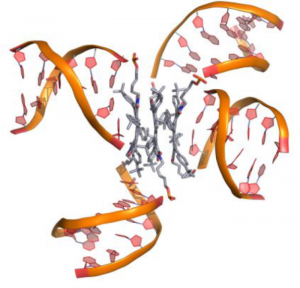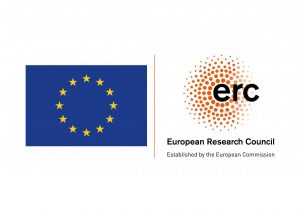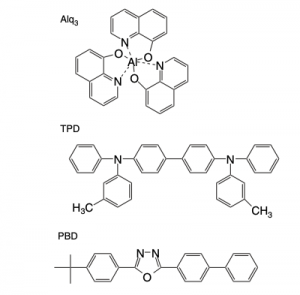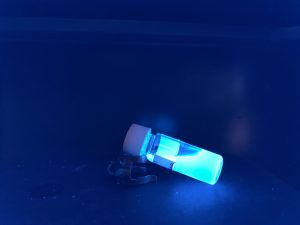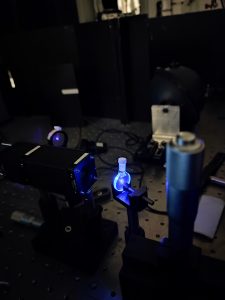Research
Molecular Semiconductors
The electronic properties of organic molecular semiconductors are controlled by the relatively strong Coulomb interactions present, causing photoexcitations to form as strongly bound excited states, excitons, that show a large spin-exchange energy between higher energy spin singlet and lower energy spin triplet states. Triplet excitons are formed by electron-hole capture in both LEDs and in solar cells, and generally lead to non-radiative losses that limit device performance. Much of our current research is concerned with spin management, to explore new physics and to develop better engineered LED and solar cell device architectures.
For LEDs we are exploring methods to control the exchange energy using molecular structures that give charge-separated excited states with low exchange energies. For organic solar cells, we are developing new systems where we can control the spin-dependent kinetics for formation and dissociation of intermolecular electron-hole bound states. We have shown how this can prevent losses through triplet exciton formation and this may allow higher organic solar cell efficiencies, which though now beyond 18% are still limited by non-radiative decay channels.
A new approach to spin management that we have found is to use semiconductor molecules that have an unpaired spin in the ground state. These ‘spin radical’ materials can be designed to show very high luminescence efficiencies and we have found that we can operate efficient LEDs entirely within the spin doublet manifold. In doing so, we have used materials designed without lower energy non-emissive states (such as spin quartets) . This work opens up a new range of molecular designs and possible novel spintronic control of optoelectronic behaviour that we are exploring in a new (October 2021) ERC-funded project, SCORS. Most recently, we have found a new class of radical molecules that show both efficient luminescence and near-unity generation yield of excited states with spin multiplicities of quartets and quintets. This was achieved by designing an energy resonance between emissive doublet and the triplet level of the adjacent unit, using covalently coupled tris(2,4,6-trichlorophenyl) methyl-carbazole radicals and anthracene. These high-spin states are coherently addressable with microwaves even at 295 K, with optical readout enabled by reverse intersystem crossing to emissive states. Furthermore, for the biradical, on return to the ground state the previously uncorrelated radical spins either side of the anthracene shows strong spin correlation.
Some molecular semiconductors can be engineered so that the spin singlet exciton is close to twice the energy of the spin triplet exciton. When this condition is met there can be very fast interconversion between the singlet exciton and a spin-zero pair of triplet excitons. The fusion of two triplet excitons to form a singlet exciton is widely used to optimise efficiency in current OLED displays. The reverse process, of singlet exciton fission to a pair of triplet excitons can also be fast and efficient. This process provides a route to improved solar cell efficiencies, where higher energy photons can be down-converted to pairs of lower energy states that are then both used to generate charge in a standard single junction solar cell [6]. We work within a large programme in Cambridge that is exploring materials [7] and device architectures to develop this photon conversion technology.
We are exploring a new class of well-ordered molecular nanofibres that we find show unprecedented long range diffusion of photogenerated excitons, beyond 300 nm [8]. This distance is large enough to use these structures as light-harvesting antenna structures for solar cell and photodetectors a we are exploring materials and structures to demonstrate this. We want to know why this long range energy transfer is possible and our current work reveals this may be due to transient thermal excitation to delocalised excited states [9].
#gallery-1 {
margin: auto;
}
#gallery-1 .gallery-item {
float: left;
margin-top: 10px;
text-align: center;
width: 100%;
}
#gallery-1 img {
border: 2px solid #cfcfcf;
}
#gallery-1 .gallery-caption {
margin-left: 0;
}
/* see gallery_shortcode() in wp-includes/media.php */
Metal Halide Perovskites
Lead halide perovskites have recently been found to provide unexpectedly efficient thin-film solar cells. We have looked instead at their light-emitting properties and find that they can show remarkably efficient luminescence which we have explored in novel LED structures [10] and in optically-pumped lasers. Our current research, now supported by a new EPSRC research grant (Oct 2021), explores new quantum well structures that we assemble with perovskites with controlled bandgaps, using two-dimensional perovskites as larger energy gap components that we use to confine electronic excitations within lower gap three-dimensional perovskite regions [11, 12].

DNA Assembly of Molecular Semiconductor Structures
The directed movement of electronic excitations in molecular materials lies at the heart of photosynthesis and also in nanoscale synthetic materials systems used for electronic applications. Efficient materials systems must span many length scales; from nm molecular dimensions, to the 10 nm length scale of Coulomb interactions at 300 K in molecular systems, to the macroscopic dimensions of biological structures and of synthetic electronic devices. We have developed a new platform to study and control electronic excitations in extended molecular systems using DNA assembly methods to construct functional molecular semiconductor stacks. DNA-assembly takes the place here of the protein structure assembly of chromophores within photosynthetic systems. In contrast to current synthetic molecular systems that have little control beyond simple heterojunctions, these DNA-assembled structures will allow for the precise placement of molecules within stack-structures of dimension 5 nm or more, which will allow for the definition of precise electronic couplings and energetic landscapes, within extended artificial molecular systems.
